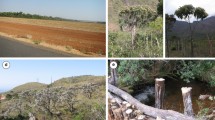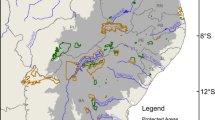Abstract
Chloraea is a diverse orchid genus with many endemic Chilean species. Many of those species have conservation problems, and the status of their populations is unknown. Chloraea disoides Lindl. is a Critically Endangered species endemic to Chile with a narrow distribution, and many of its registered populations are located in highly disturbed sites. The restricted distribution, the increasing anthropic disturbances, and global change could lead to the rapid extinction of C. disoides. Our work aims to characterize actual populations (in Valparaíso and one in Angol), design an index to determine the conservation status of these populations, and study the potential impact that the reduction in precipitations could have on the distribution of this species, as predicted by climate change models. Using herbarium data and field collections, we registered the populations of C. disoides present in Chile and modeled the potential distribution of the species using computer models based on climatic variables. We also characterized two populations at the two ends of its distribution (Valparaíso in the north and Angol in the south). The predictive model resulted in a very narrow potential distribution for the species, superposing known populations. Some of the historical populations are now urbanized areas. Valparaíso (northern) populations presented a very low density of C. disoides individuals. Both studied populations were highly disturbed with evidence of cattle damage and human influence. Chloraea disoides is seriously threatened by anthropogenic disturbances, especially since its distribution is very narrow and the species is not well represented in protected areas. Conservation initiatives should include protection of some of the natural populations and ex situ reproduction/propagation using fungal isolates.

Similar content being viewed by others
References
Alarcón D, Cavieres LA (2015) In the right place at the right time: habitat representation in protected areas of South American Nothofagus-dominated plants after a dispersal constrained climate change scenario. PLoS ONE 10(3):e0119952. doi:10.1371/journal.pone.0119952
Anderson R, Lew D, Peterson A (2003) Evaluating predictive models of species’ distributions: criteria for selecting optimal models. Ecolo Model 162:211–232
Becerra PI (2006) Invasión de árboles alóctonos en una cuenca pre-andina de Chile central. Gayana Botanica 63:161–174
Bronstein JL, Armbruster WS, Thompson JN (2014) Understanding evolution and the complexity of species interactions using orchids as a model system. New Phytol 202:373–375
Castillo Soto M, Quintanilla Pérez V (2009) Degradación de ecosistemas de la palma más austral del mundo (Jubaea Chilensis) acelerada por los fuegos estivales en los cordones litorales de Valparaíso y Viña del Mar (32′50′-33″ 02′s). Un caso sostenido de perturbación del paisaje. Universidad de Chile. Investigaciones Geográficas 41:41–60
Colwell R, Rangel T (2009) Hutchinson’s duality: the once and future niche. Proc Natl Acad Sci 106:19651–19658
CONAMA - Comisión Nacional del Medio Ambiente 2006. Estudio de la variabilidad climática en Chile para el siglo XXI, Van Nieuwenhuizen final. Universidad de Chile, Santiago, Chile. http://dgf.uchile.cl/PRECIS/articles-39442_pdf_Estudio_texto.pdf. Accessed March 2016
CONAMA—Comisión Nacional del Medio Ambiente, PNUD (2005). Estrategia y plan de acción para la conservación de la diversidad biológica. http://www.sinia.cl/1292/articles-37028_pdf_valpo.pdf. Accessed June 2016
Correa M (1969) Chloraea género sudamericano de Orchidaceae. Darwiniana 15:374–500
(CR)2—Centro de ciencia del clima y la resiliencia (2015) La megasequía 2010-2015: una lección para el futuro, informe a la nación. Universidad de Chile, Santiago. http://www.cr2.cl/wp-content/uploads/2015/11/informe-megasequia-cr21.pdf
Elórtegui S, Novoa P (2009) Orquídeas de la Región de Valparaíso. Taller La Era, Viña del Mar
Flores-Toro L (2012) Estudio fitosociológico de varias áreas disyuntas del norte de la región de Valparaíso (Chile); sintaxonomía de la vegetación mediterránea y su interés para la conservación. Tesis Doctoral, Facultad de Biología, Universidad de Santiago de Compostela, Santiago de Compostela, España
Fuentes N, Sánchez P, Pauchard P, Urrutia P, Cavieres L (2014) Plantas invasoras del centro-sur de Chile: Una guía de campo. Laboratorio de Invasiones Biológicas (LIB), Concepción
González A (2000) Evaluación del recurso vegetacional en la cuenca del río Budi, situación actúa y propuestas de manejo. Tesis Licenciatura en Recursos Naturales. Escuela de Ciencias Ambientales, Facultad de Ciencias, Universidad Católica de Temuco, Temuco
Guisan A, Zimmermann N (2000) Predictive habitat distribution models in ecology. Ecol Model 135:147–186
Guisan A, Lehmann A, Ferrier S, Austin M, Overton J, Aspinall R, Hastier T (2006) Making better biogeographical predictions of species’ distributions. J Appl Ecol 43:386–392
Hijmans R, Cameron S, Parra J, Jones P, Jarvis A (2005) Very high resolution interpolated climate surfaces for global land areas. Int J Climatol 25:1965–1978
IPCC—Intergovernmental Panel on Climate Change (2013) Fifth Assessment report- AR5, Geneva, Switzerland
Jorquera-Jaramillo C, Vega JMA, Aburto J, Martínez-Tillería K, León MF, Pérez MA, Gaymer CF, Squeo FA (2012) Conservación de la biodiversidad en Chile, nuevos desafíos y oportunidades en ecosistemas terrestres y marinos costeros. Revista Chilena de Historia Natural 85:267–280
Liaw A, Wiener M (2002) Classification and Regression by randomForest. R News 2:18–22
Micheneau C, Johnson SD, Fay MF (2009) Orchid pollination: from Darwin to the present day. Bot J Linn Soc 161:1–19
Ministerio del medio ambiente (2011) Reglamento de clasificación de especies. Sexto proceso de clasificación de especies silvestres según categoría de conservación. Decreto Supremo N°41/2011, MMA
Novoa P, Espejo J, Alarcón D, Cisternas M, Domínguez E (2015) Guía de campo de las orquídeas chilenas, segunda ed. ampliada. Ediciones Corporación Chilena de la Madera, Concepción
Núñez JH, Verbist K, Wallis JR, Schaefer MG, Morales L, Cornelis WM (2011) Regional frequency analysis for mapping drought events in north-central Chile. J Hydrol 405:352–366
Pedersen HÆ, Rasmussen HN, Kahandawala IM, Fay MF (2012) Genetic diversity, compatibility patterns and seed quality in isolated populations of Cypripedium calceolus (Orchidaceae). Conserv Genet 13:89–98
Pereira G, Romero C, Suz L, Atala C (2014) Essential mycorrhizal partners of the endemic Chilean orchids Chloraea collicensis and C. gavilu. Flora. 209:95–99
Phillips SJ, Anderson RP, Schapire RE (2006) Maximum entropy modeling of species geographic distributions. Ecol Model 190:231–259
Primack R, Rozzi R, Feinsinger P, Dirzo R, Massardo F (2001) Fundamentos de conservación biológica, perspectivas latinoamericanas. Primera edición. Fondo de Cultura Económica, Ciudad de México, México
R Development Core Team (2011) R: A language and environment for statistical computing. R Foundation for Statistical Computing, Vienna. http://www.r-project.org/. doi: 10.1002/jcc.22917
Ramirez C, San Martin C, Ojeda P (1997) Muestreo y tabulación fitosociológica aplicados al estudio de los bosques nativos. Bosque 18:19–27
Rasmussen HN, Dixon KW, Jersakova J, Tesitelova T (2015) Germination and seedling establishment in orchids: a complex of requirements. Ann Bot 116:391–402
Reiche C (1910) Orchidaceae Chilensis: Ensayo de una Monografía de las Orquídeas de Chile. Anales del Museo Nacional de Chile, Segunda Sección Botánica, Santiago, Chile
Reszka P, Fuentes A (2015) The Great Valparaiso Fire and Fire Safety Management in Chile. Fire Technol 51:753–758
Rojas I, Becerra P, Gálvez N, Laker J, Bonacic C, Hester A (2011) Relationship between fragmentation, degradation and native and exotic species richness in an Andean temperate forest of Chile. Gayana Botánica 68:163–175
Romero C (2012) Orquídeas de Nahuelbuta, Símbolo de la Comuna de Angol. Fondo de Protección Ambiental. Ministerio de Medioambiente, Gobierno de Chile
Soberón J, Nakamura M (2009) Niches and distributional areas: concepts, methods, and assumptions. Proc Natl Acad Sci 106:19644–19650
Swarts ND, Dixon KW (2009) Perspectives on orchid conservation in botanic gardens. Trends in plants science 14:590–597
Thuiller W, Lafourcade B, Engler R, Araújo MB (2009) BIOMOD—A platform for ensemble forecasting of species distributions. Ecography 32:369–373
Wake DB, Hadly EA, Ackerly DD (2009) Biogeography, changing climates, and niche evolution. Proc Natl Acad Sci USA 106:19631–19636
Zuloaga F, Marrone O, Belgrano M (2008) Flora del conosur, catalogo de las plantas vasculares del conosur, Volumen 1, Chile
Acknowledgements
The support to this work under Grant Nos. Project PIA-iniciación 037.480/2013 (PUCV) and Project DI-iniciación 037.371/2014 is gratefully acknowledged. The authors would like to thank three anonymous reviewers for their valuable critical comments that greatly helped to improve the final version of the paper.
Author information
Authors and Affiliations
Corresponding author
Rights and permissions
About this article
Cite this article
Atala, C., Muñoz-Tapia, L., Pereira, G. et al. The effect of future climate change on the conservation of Chloraea disoides Lindl. (Orchidaceae) in Chile. Braz. J. Bot 40, 353–360 (2017). https://doi.org/10.1007/s40415-016-0333-4
Received:
Accepted:
Published:
Issue Date:
DOI: https://doi.org/10.1007/s40415-016-0333-4




